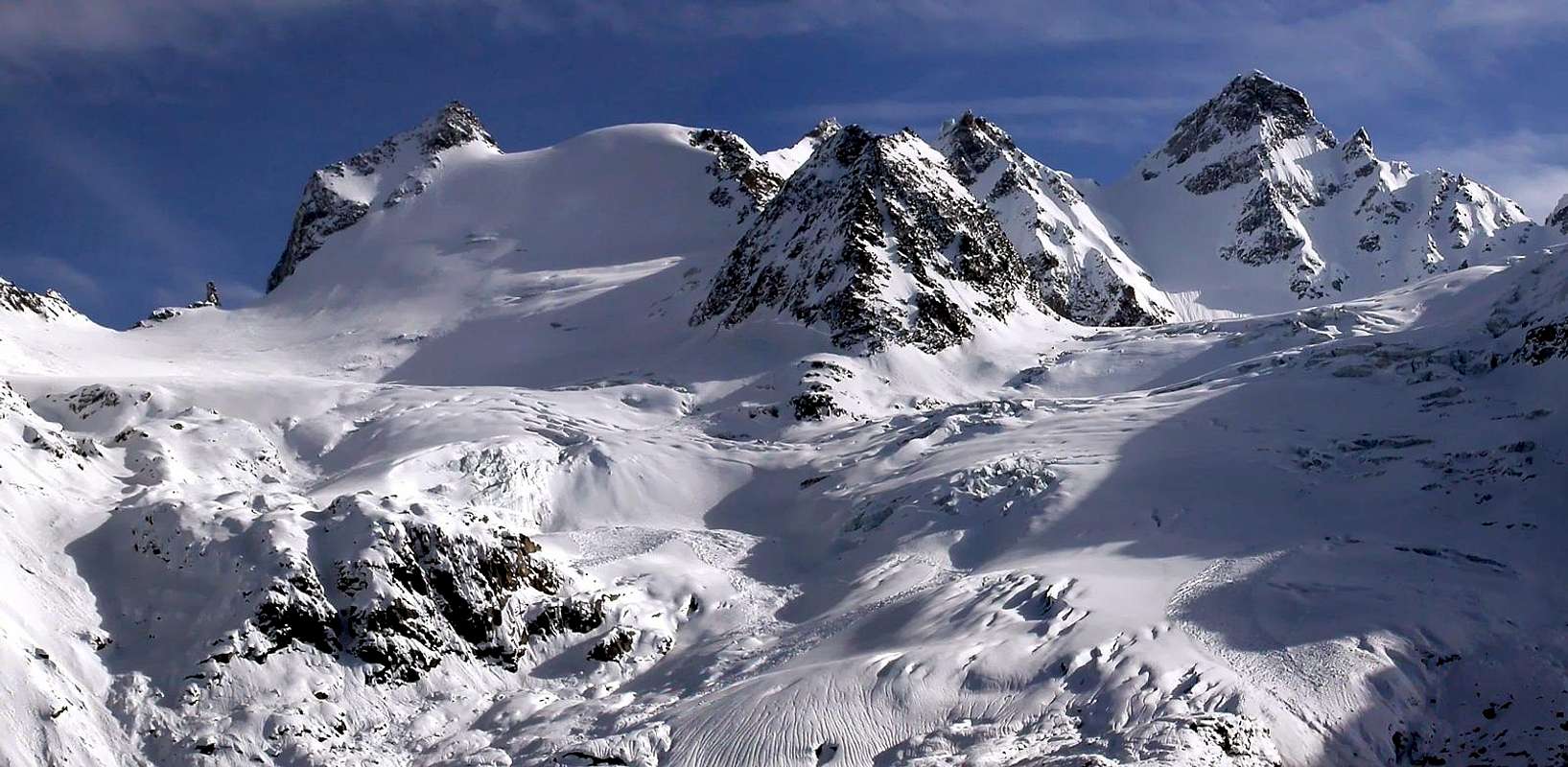-
 3509 Hits
3509 Hits
-
 82.48% Score
82.48% Score
-
 15 Votes
15 Votes
|
|
Route |
|---|---|
|
|
45.52700°N / 7.35797°E |
|
|
Mountaineering, Trad Climbing |
|
|
Summer |
|
|
A long day |
|
|
II°+ |
|
|
III |
|
|
Note
|
La montagna chiama i suoi figli, ed essi rispondono fedelmente al suo appello… Osvaldo Cardellina, Diario alpinistico, 1964-65 Page texts: @ OsvaldoCardellina "Osva", passed away on May 2, 2022. Page owners: Christian Cardellina e Osvaldo Cardellina. Any updates from September 12, 2022: Antonio Giani, page administrator, friend and climbing companion. Testi della pagina: @ OsvaldoCardellina "Osva", scomparso il 2 maggio 2022. Proprietari pagina: Christian Cardellina e Osvaldo Cardellina. Eventuali aggiornamenti dal 12 settembre 2022: Antonio Giani, amministratore della pagina, amico e compagno di salite. |
Overview


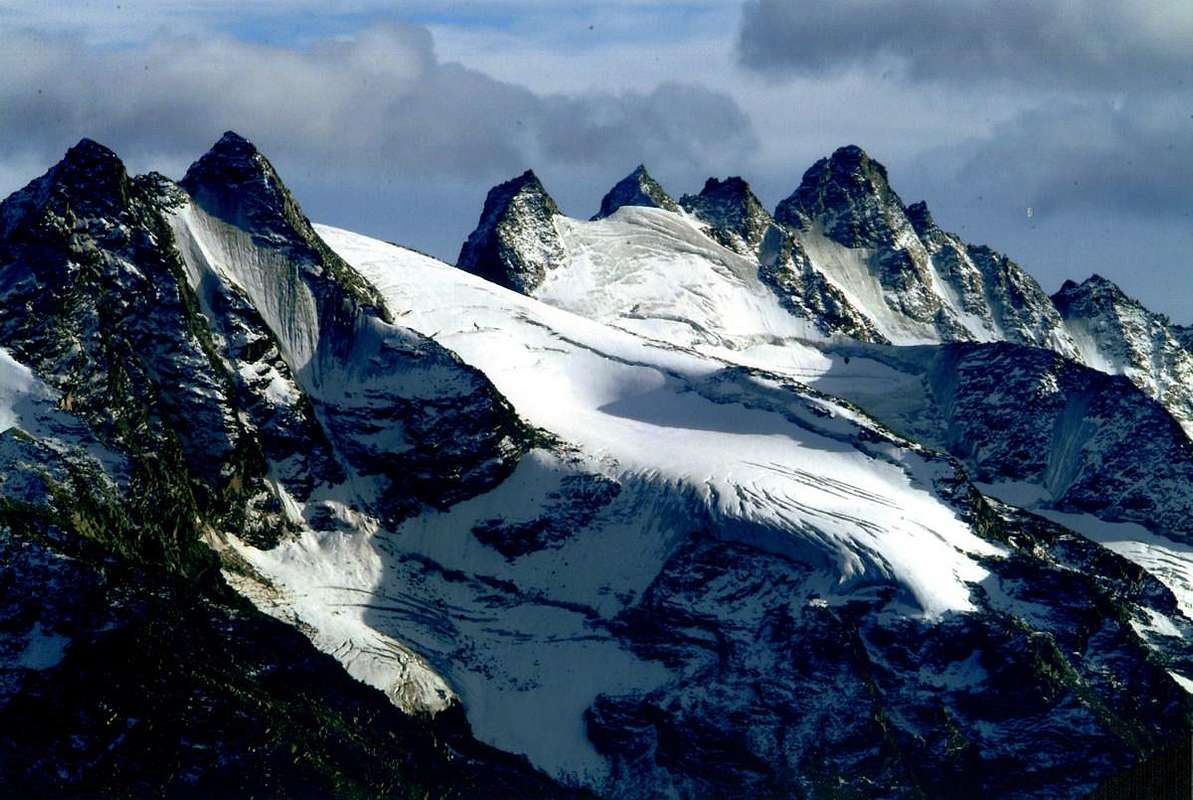
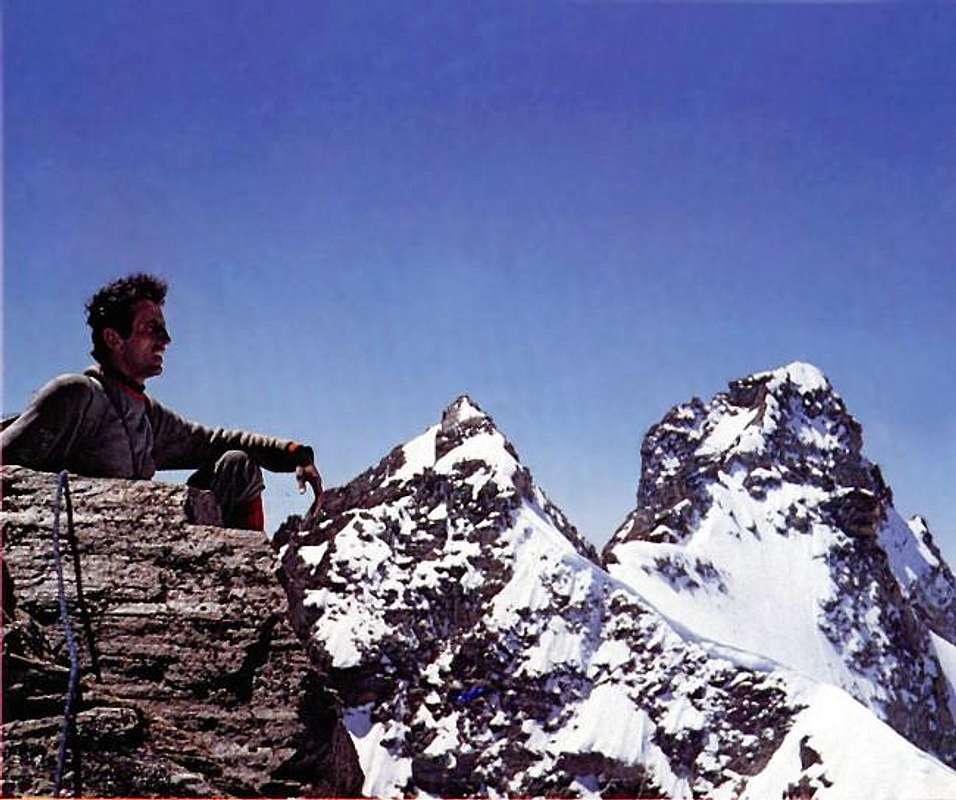
Getting There
BY CAR:
- From TORINO, MILANO, etc: Motorway A5. Exit at IVREA or Quincinetto (PIEDMONT) also Pont Saint Martin, Verrès, Chatillon, AOSTA East (Nus) and West (Aymavilles) Municipalities (AOSTA Valley). From IVREA Town to Hone-Bard, Pont Bozet, Champorcher, Aymavilles, Villeneuve.
- From Aymavilles towards Cogne Valley
From Aymavilles (646m) towards Cogne Valley with Regional Main Road: Vieyes (1.132m) Fraction; continue to Silvenoire, Epinel and Crétaz Hamlets, Cogne (1.534m) Resort, through Main Road. To Valnontey (1.678m), through Municipal Road: to Money, Alessandro Martinotti, Stefano Borghi Bivouacs, through paths, moraines and glaciers. From Lillaz Fraction (1.607m) to Guido Antoldi & Laura Malvezzi Bivouac, by paths in Valeille Vallon, with traces in terminal parts.
It is not necessary to take Motorway A5: you can drive on SS.26, in the direction of AOSTA - IVREA - TURIN.
BY PLANE:
- Aeroporto "Corrado Gex" Saint Christophe (Aosta).
Approach & Routes Descriptions
From Cogne (1.534m) along the Regional Road (public bus or by car) to Valnontey Hamlet (1.666m - wide car parking in soil). Along the Valnontey Vallon on its left side (East) through the trail n° 22/TVC and after the fine Valmiana Alpage (1.728m) follow the mule track till the fork (T/E; 0h'45) that, on the left and with path n° 22C/TVC, leads to the Money Houses. After (T/E; 2h'00/2h'20) walk you can see the Money and, little before getting there, keeping the left side, ascend along some morainic slopes and along the ridge of the lateral moraine (orographic right of the Coupè di Money Glacier. Along the same, which progressively increases in steepness, on small tracks, where it ends cross to the left a small valley of debris and broken rocks, up along a short but steep slope of rocks (anchors and chains) to get the well visible (yellow signs) Money Bivouac in color yellow ocher, while little above the bivouac (some anchors and chains) you can find the water coming out from the Southern Patrì Glacier. (2.872m; 1h'15/1h'30 from Money).
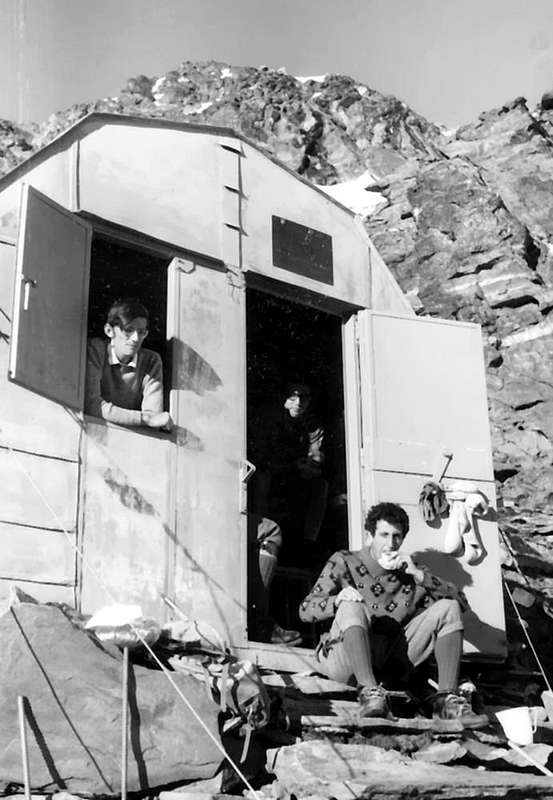
Dall'abitato di Cogne (1.534 m) in bus o in auto sino al Villaggetto di Valnontey (1.666 m) ove si parcheggia nell'ampio piazzale in terra battuta, salire la Valnontey tramite il sentiero n° 22/TVC sul versante della destra orografica e superato l'ameno Alpeggio di Valmiana (1.728 m) si prosegue per la mulattiera sino al bivio che sale verso sinistra con sentiero n° 22C/TVC per i Casolari del Money (E/T; 0h'45). Dopo circa 2h'00/2h'20 si notano i sopracitati casolari posti a quota 2.325 metri poco prima di raggiungerli sempre sulla sinistra superare alcuni pendii morenici risalire il dorso della morena laterale (destra orografica del Ghiacciaio di Coupé di Money). Salire la medesima sulla cresta su poco evidenti tracce di sentiero, alla fine della stessa, che progressivamente và aumentando in ripidezza, attraversare a sinistra un valloncello di sfasciumi e rocce rotte, superare il breve tratto di rocce abbastanza ripide (con l'ausilio di alcune catene fisse) precedenti di poco il Bivacco del Money (2.872 m; 1h'15/1h'30 dai Casolari del Money). Il bivacco è colorato in giallo ocra, mentre l'acqua, fuoruscente dal Ghiacciaio Meridionale di Patrì, si può trovare appena sopra il medesimo raggiungibile sempre con l'ausilio di catene fisse.
To Gran San Pietro (3.692m), highest amongst the Towers: from the Money Camp, toward the right side (orographic) of Coupè di Money Glacier, cross it crosswise to the base of the Cresta Paganini (3.440m), round it and follow along the Money Glacier (careful to the crevasses that may force to many bypassings) toward the icy slope between the Torre di Sant'Andrea and the Gran San Pietro Tower. Quite easily pass the terminal crevasse, generally closed and that in any case is passed smoothly, and start climbing the slide (220 meters arond). The slant is between 45° and 55°, bearing in mind that little by little that we move away from the central couloir to the right on the Face North-northwest the slope increases dramatically. Caution to the ending snowy corniche could be very thin, stay some metres below the same and reaching the San Pietro Pass in it highest part to the right (South; 3.558 m). Gradually climb over the Northern Crest of Great Saint Peter taking on its Eastern Slope, where a rocky couloir, easy but very steep and exposed leads to the Cross of the Summit. Also in integral on edge of the ridge a little most difficult (II°+/III°-; A/PD; 1h'00 from the saddle with the Tower of Sant'Andrea; 1h'50 from base). Made the descent with the same via, back to the small saddle, often reached by both sides to reach the Vertex, but never crossed it in one that in another sense. Now to the left for some metres to get the ridge leading to the Southern St. Andrea Tower (more precisely Southwest) through the easy Crest South-southwest with some deviation on both sides (3.640m); keeping the crest down to the small saddle and, descending through more than short Crest Northwest, and, bypassing an elevation to the Western side or Money (be very careful to the upper terminal crevasse that often can not be seen but there is subtly) through rocks rather steep but not too difficult, on again to the Northern Summit (better Northeast; 3.651m; A/PD-; 3h'30/4h'00 from bivouac). From the Northern Tower down through the North Ridge quite easy, through the watershed that after a small highlight (3/4 metres, II°-) become sharp and dangerous cornices in the Northeast (the conditions, for the same period in the year, were quite varied from the late sixties to the mid-eighties), to reach the Col de Saint André (3.574m) from which, after a subsequent harness or Paganini Col (3.555m), easily and quickly reach the St. Orso Tower through the brief Southwestern Crest before in snow up to the altitude 3.618 metres then by the easy and rotten rock in the form of blocks (A/PD-/PD; 2h'00/2h'30 by Gran San Pietro). The descent is via the Northwest Wall: first place to the left (West) towards the Cresta Paganini up to the quota 3610 metres, then dropped directly on Glacier Coupé de Money with a slope between 35° and 40°, without forced route but, generally by diagonal descent from left/right to reach the bergschrund or final crevasse on Glacier Coupé de Money to altitude 3.280/3.300 metres around. Through the same with more "high" route to Northwest it falls to Money Camp, or go down directly in Valnontey, making sure that the top of the moraine is quite steep and a few years ago registered is a fatal accident on the way back from the Punte Patrì (A/PD-; 1h'00; in total 6h'30/7h'30).
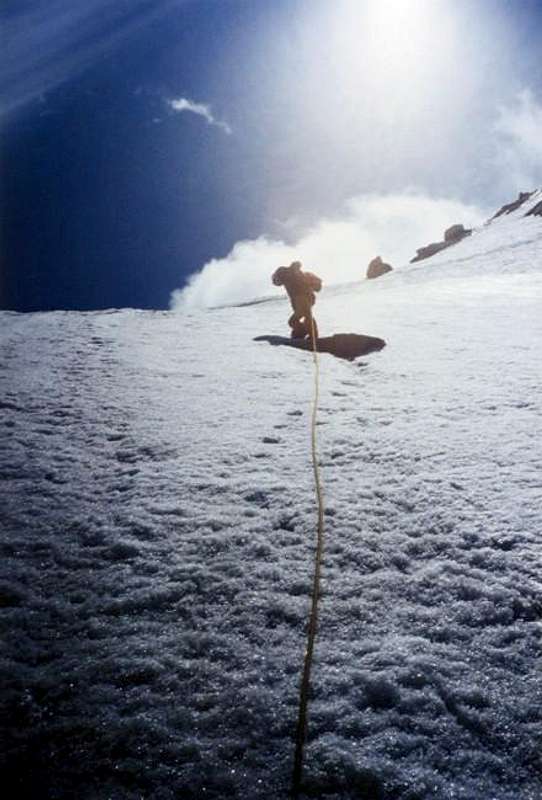
Al Gran San Pietro (3.692 m), il più elevato delle Torri: dirigersi a Sudest in direzione della destra orografica del Ghiacciaio del Coupé di Money e, attraversandolo diagonalmente verso la base terminale della Cresta Paganini (3.440 m), aggirare la stessa; da qui procedere decisamente sul Ghiacciaio del Money, facendo attenzione ai numerosi crepacci che a volte costringono a fastidiosi aggiramenti, verso lo scivolo ghiacciato tra la Torre di Sant'Andrea e la Torre del Gran San Pietro. Con precauzione superare la terminale, in genere chiusa nonché agevole da passare, e iniziare la salita dello scivolo (circa 220 m) con pendenze varianti tra i 45° ed i 55°, tenendo presente che a poco a poco che ci si allontana dal couloir centrale e verso destra sulla Faccia Nord-nordovest la pendenza aumenta notevolmente. Fare attenzione al cornicione finale che potrebbe essere molto sottile, restando qualche metro al disotto del medesimo e raggiungendo il Colle di San Pietro nella sua parte più elevata verso Mezzogiorno (3.558 m). Progressivamente scavalcare la Cresta Settentrionale del Gran san Pietro portandosi sul suo Versante Orientale, dove un canale roccioso, facile ma ripido e molto esposto conduce alla Croce della Cima, oppure sul filo di cresta con percorso un pò più difficile ed esposto su entrambi i lati (possibilità di incontrare "verglass", II°+/III°-; A/PD; 1h'00 dalla selletta; 1h'50 dalla base). Effettuata la discesa, con la stessa via, rientrare alla selletta, spesso raggiunta da ambo i lati (i primi salitori E. Carr e A.F. Mummery da Est, il 2 Agosto 1891) per raggiungere la Vetta, ma mai attraversata sia nell'uno che nell'altro senso. Da qui portarsi verso sinistra per alcuni metri ed iniziare su cresta la salita alla Torre Sant'Andrea Meridionale (meglio Sudovest) tramite la facile Cresta Sud-sudovest con qualche deviazione su entrambi i lati (3.640 m); sempre sulla cresta ridiscendere per mezzo della più che breve Cresta Nordovest, e, aggirando un'elevazione ad Ovest sul versante Money (fare molto attenzione alla terminale superiore che spesso non si vede ma subdolamente esiste e scende ancor più pericolosamente sinuosa contro le rocce) tramite rocce piuttosto ripide ma non troppo difficili, salire alla Torre Settentrionale (o Nordest; 3.651 m); A/PD-; 3h'30/4h'00 dal Bivacco di Money). Dalla Torre Settentrionale scendere con l'abbastanza facile Cresta Nord, tramite lo spartiacque che dopo un piccolo risalto (3/4 metri, II°-) diventa affilato e con pericolose cornici a Nordest (le condizioni, a parità di periodo nell'anno, erano alquanto variate dalla fine degli anni sessanta a metà degli ottanta) raggiungendo il Col de Saint André 3.574 m dal quale, dopo una successiva selletta o Col Paganini (3.555m), facilmente ed in breve tempo si raggiunge la Torre di Sant'Orso dapprima con una crestina nevosa sino alla quota 3.618 metri e poi per mezzo di facili rocce a blocchi (A/PD-/PD; 2h'00/2h'30 dal Gran San Pietro). La discesa avviene tramite la ghiacciata Parete Nordovest; subito appoggiare a sinistra (Ovest) verso la Cresta Paganini sino alla quota 3.610 metri, poi scendere direttamente sul Glacier Coupé de Money tramite un pendio tra i 35° e 40° senza percorso obbligato ma, generalmente con diagonale in discesa da sinistra verso destra onde raggiungere la crepaccia terminale sul Glacier Coupé de Money a quota 3.280/3.300 metri circa. Attraversato il medesimo "alti" verso Nordovest si rientra al bivacco, oppure si scende direttamente in Valnontey, facendo attenzione che la parte superiore della morena é alquanto ripida e qualche anno orsono s'é registrato un incidente mortale al ritorno dalle Punte Patrì (A/PD-; 1h'00; complessivamente 6h'30/7h'30).

Difficulties & Equipment
DifficultiesThis route can be considered from PD- up to the AD- (depending on mountain and ice conditions).
L'itinerario è classificato da PD- sino a AD- (dipende dalle condizioni della montagna).
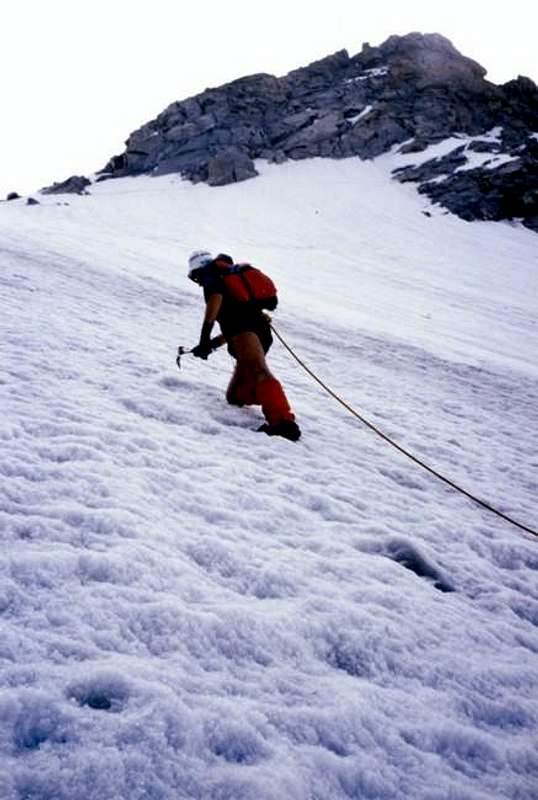
Equipment
For Mountaineering with rope, ice-axe and crampons.
Da Alpinismo con corda, piccozza e ramponi.
Mountain Condition
- Meteo: you can find all the needed informations at the official site of the Valle d'Aosta Region:
- Valle d'Aosta Meteo
- Meteo: You can find more weather information on the website 3B Meteo:
- Meteo Cogne
- Meteo: You can find more weather information on the website 3B Meteo:
- Meteo Valnontey
Books and Maps
- "Guida delle Alpi Occidentali" di Giovanni Bobba e Luigi Vaccarone C.A.I. Sezione di Torino Volume II° (parte II) 25-05-1896.
- "Guida dei Monti d'Italia-Gran Paradiso Parco Nazionale" E. Andreis, R. Chabod, M. C. Santis, Club Alpino Italiano/Touring Club Italiano, prima Ed. 1939; seconda Ed. 1963; terza Ed. 1980.
- "Rifugi e bivacchi in Valle d'Aosta" di Cosimo Zappelli aggiornata da Pietro Giglio. Musumeci Editore, Luglio 2002.
- "Il Parco Nazionale del Gran Paradiso (Valli di Champorcher-Clavalitè-Saint Marcel-Laures-Cogne-Valsavarenche-Conca di Pila" di Giulio Berutto 3/volume 2°, IGC, Torino 1981, 2a Ed. 2000.
- "Gran Paradiso - Itinerari Alpinistici e sci Alpinistici" di Franco Brevini Ed. Musumeci, Giugno 1982.
- "Diari Alpinistici" di Osvaldo Cardellina e Indice Generale accompagnato da Schedario Relazioni Ascensioni 1964-2019 (inediti).
- Kompass - "Gran Paradiso Valle d'Aosta Sentieri e Rifugi" Carta Turistica 1:50000.
- Enrico Editore Ivrea-Aosta – "Gruppo del Gran Paradiso" 1:50000.
- I.G.C. Istituto Geografico Centrale Torino "Gran Paradiso-La Grivola-Cogne" 1:25.000.
- A.I.A.T. "Cogne Gran Paradiso Aymavilles - Walking Map" 1:25.000.
- I.G.C. Istituto Geografico Centrale Torino "Il Parco Nazionale del Gran Paradiso" (3) 1:50.000.
- L'Escursionista "Valle di Cogne Carta dei Sentieri" (n° 10) 1:25.000.
- L'Escursionista "Tour de la Vallée de Cogne Grand Paradis" Carta dei sentieri 1:25.000.
Important Information
- REGIONE AUTONOMA VALLE D'AOSTA the official site.
- FONDAZIONE MONTAGNA SICURA Villa Cameron, località Villard de la Palud n° 1 Courmayeur (AO) Tel: 39 0165 897602 - Fax: 39 0165 897647.
- SOCIETA' GUIDE ALPINE DI COGNE Tel. 347/9473526 – 328/1373728.
- A.I.NE.VA. (Associazione Interregionale Neve e Valanghe).
- A.IA.T. Cogne Gran Paradis via Bourgeois n° 34 Tel. 0165-74040. E-mail: aiat@cogne.org
- Soccorso Alpino Cogne (SAR) Tel. 3482685406.
- Protezione Civile Valdostana località Aeroporto n° 7/A Saint Christophe (Ao) Tel. 0165-238222.
- Bollettino Meteo (weather info) Tel. 0165-44113.
- Unità Operativa di Soccorso Sanitario Tel. 118.




